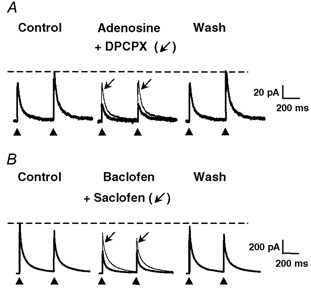Figure 1. Effect of adenosine and baclofen on the amplitudes of electrically evoked GABAergic eIPSCs in isolated pairs of DH neurones.

A paired-pulse stimulation protocol consisting of two identical pulses (0.1 ms duration) separated by 400 ms was applied at a frequency of 0.1 Hz. The GABAergic eIPSCs were recorded in isolation at a holding potential (HP) of 0 mV. A, adenosine (10 μm) reversibly decreased the amplitudes of GABAergic eIPSCs (thick traces). This phenomenon was accompanied by a change in the paired-pulse ratio, indicating a presynaptic site of action of adenosine. The effect of adenosine was strongly reduced in the presence of 1 μm DPCPX (thin traces, arrow), suggesting the involvement of A1 receptors. B, baclofen (10 μm) also reduced the amplitudes of GABAergic eIPSCs (thick traces) and changed the paired-pulse ratio of eIPSCs. The effect of baclofen was completely reversible and strongly attenuated by 100 μm saclofen (thin traces, arrow), suggesting the involvement of GABAB receptors. In this and following figures displaying electrically evoked synaptic currents, the control and wash traces are averages of 20 individual consecutive traces, and traces in the presence of pharmacological substances are averages of 10 individual and consecutive traces. The black arrowheads below the traces indicate the times of application of the electrical stimuli to the presynaptic neurone, and the dashed horizontal lines indicate the amplitude of the second (panel A) or first (panel B) eIPSC under control conditions.
